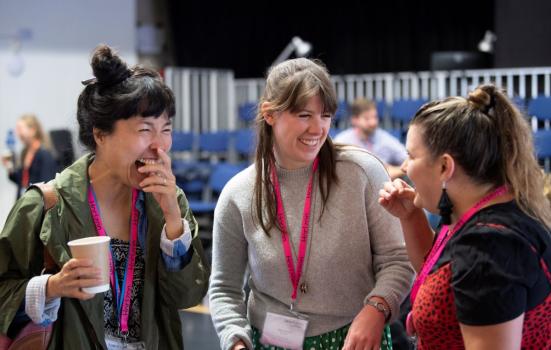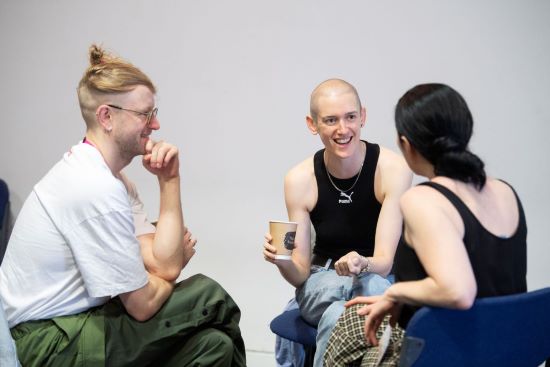With a showcase of performance work headed for the Edinburgh festivals next month, Horizon’s Hannah Slimmon shares how matchmaking helps catalyse international working.

Lesley Martin
England-based artists face a lot of barriers to international working. Alongside the practical challenges of touring post-Brexit, there’s also funding pressures, precarious freelance work, colonial legacy and political issues to contend with.
At Horizon, our ambition is to support visionary artists based in England to develop meaningful relationships with international venue and festival presenters. We work to create the best context for artist and presenter conversations, based on exchange and dialogue.
Our consortium model is very effective; the partner organisations work year-round on international exchange and engagement, and this directly benefits Horizon’s work by demonstrating our commitment to reciprocity.
Collective intelligence
My role has a few elements but a key one is matchmaking. This is crucial for ensuring the connections artists make at the showcase are meaningful and have the best chance of developing into international touring, residencies and new projects.
I’ve been involved in international showcasing for the last ten years as both a participant and an organiser, and my approach is based on feedback, observations and first-hand experience. My background is in producing and touring contemporary performance, so I have a good understanding of the challenges facing performance makers in the UK, as well as the best strategies for engaging with international presenters.
"International presenters are looking for work that is innovative, pushes the boundaries of art form and spotlights diverse voices."
Sophisticated matchmaking starts when we select the artists for the showcase. As always with programming it’s essential to know your audience and for Horizon that means understanding what work will appeal to our audience of international venue and festival programmers.
Another great thing about working in a consortium is the scale of the presenter network we can access (my database has over 1,000 international contacts). Through this collective intelligence, we know that international presenters are looking for work that is innovative, pushes the boundaries of art form and spotlights diverse voices. So, this is the kind of work we look to programme, which means we can be confident from the outset that the work in the showcase has the best chance of success.
Selection process
We also invite international presenters to be part of the selection process. The 2023 panel included colleagues from Canada, The Netherlands, Brazil and Japan. The next step is the invitation list. I match the selected shows with the presenters in our network whom I believe are the most likely to programme it. I consider the artists’ ambitions and any specific presenters or regions they want to connect with.
Having a cohesive programme means that all the presenters attending the showcase share common ground, which increases the potential for presenter-to-presenter partnerships that in turn can benefit the artists with joined up touring and co-commissioning.
The next stage of matchmaking is our networking events, where we take a very hands-on approach. Some people love open networking events, but they make me anxious. And I know from experience that many artists and presenters find them challenging too. I don’t believe making connections should rely on how comfortable you feel approaching strangers.
 Photo: Lesley Martin
Photo: Lesley Martin
Structured networking
To remove awkwardness and hierarchy, and give conversations the best chance of success, I pair artists and presenters for a series of 10-minute chats. Each artist has their own space and the delegates are guided between meetings by the Horizon team.
Each of these structured networking events is followed by lunch, creating space for the artists and presenters to keep chatting in a more informal way, and we host a post-show drinks every evening as well.
Showcasing is usually just the first step in a relationship with a presenter. It provides a moment of visibility and an initial connection, but these connections can take years to come to fruition. I encourage artists to talk about their whole practice - previous work and work in development - not just their work in the showcase. This creates more points of connection, and moves away from ‘selling’, which I don’t feel is conducive to building long term relationships.
Horizon also offers showcase artists support for onward touring. These are small investments, typically £3-9k, that catalyse international presentations and relationships. To date, every £1 Horizon invests has levered £2.33 from international partners.
Outcomes
This approach gets results. The 2022 showcase has so far resulted in 16 pencilled and confirmed international tour dates, two residencies and one commission, with a projected income to artists of £165,000 (131% return on Horizon’s direct presentation fees).
Successes include 2022 artists Dan Daw being commissioned for a new large-scale work by Kampnagel (Germany); Transform & BAC (UK); Sung Im Her performing in Turkey and Germany; and Sonia Hughes performing in Denmark and South Africa. I can’t wait to see where the 2023 artists will take their work after this year’s showcase.
Hannah Slimmon is International Development Manager for Horizon – Performance Created in England.
![]() horizonshowcase.uk/
horizonshowcase.uk/
![]() @ hrzn_showcase | @hannahslimmon
@ hrzn_showcase | @hannahslimmon
*Horizon is a performing arts showcase at the Edinburgh festivals commissioned by Arts Council England and delivered by a consortium comprising Battersea Arts Centre, FABRIC, Fierce, GIFT, MAYK and Transform. Horizon showcase runs from 20 to 27 August at Edinburgh Festival Fringe.




